
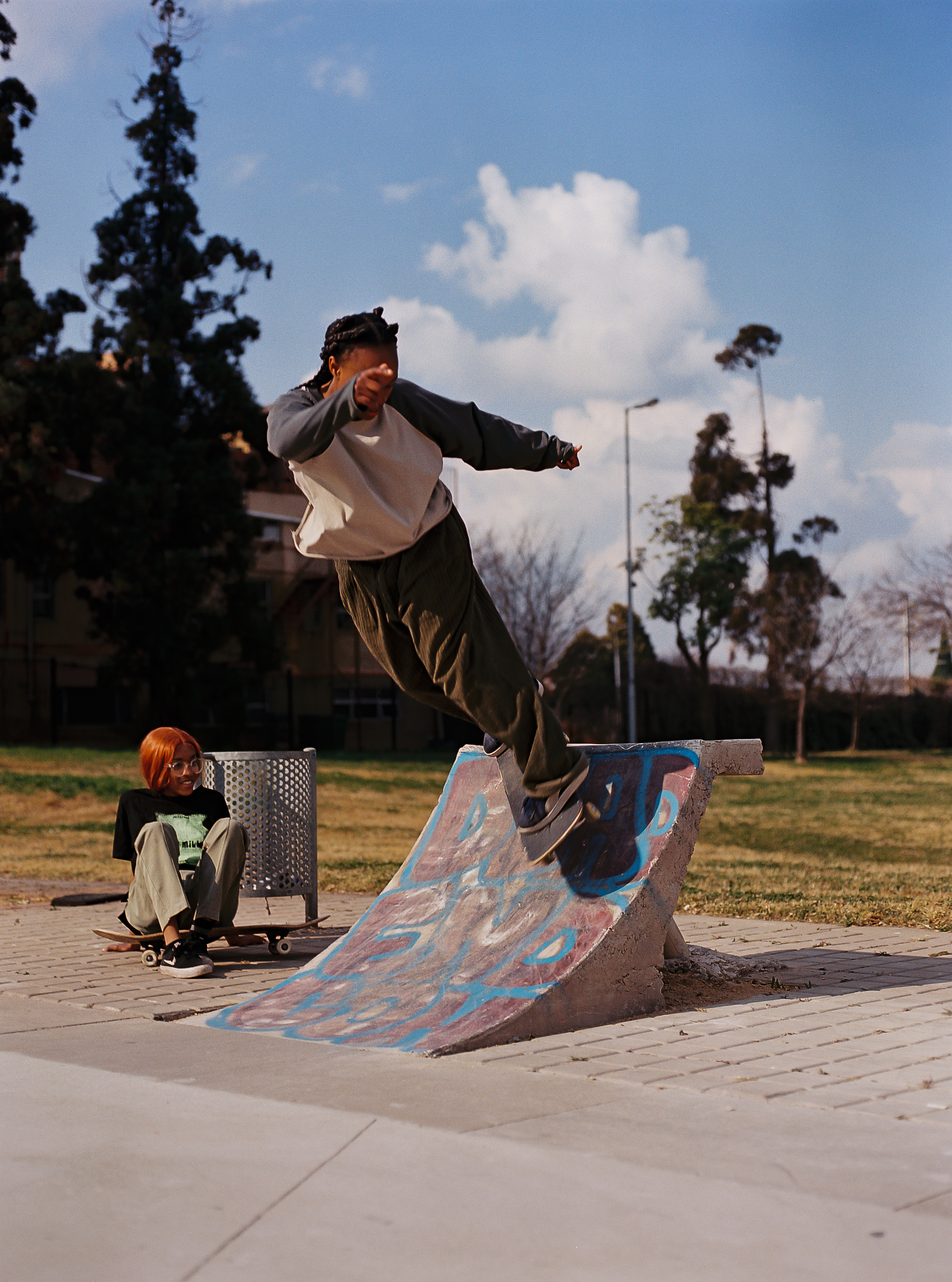
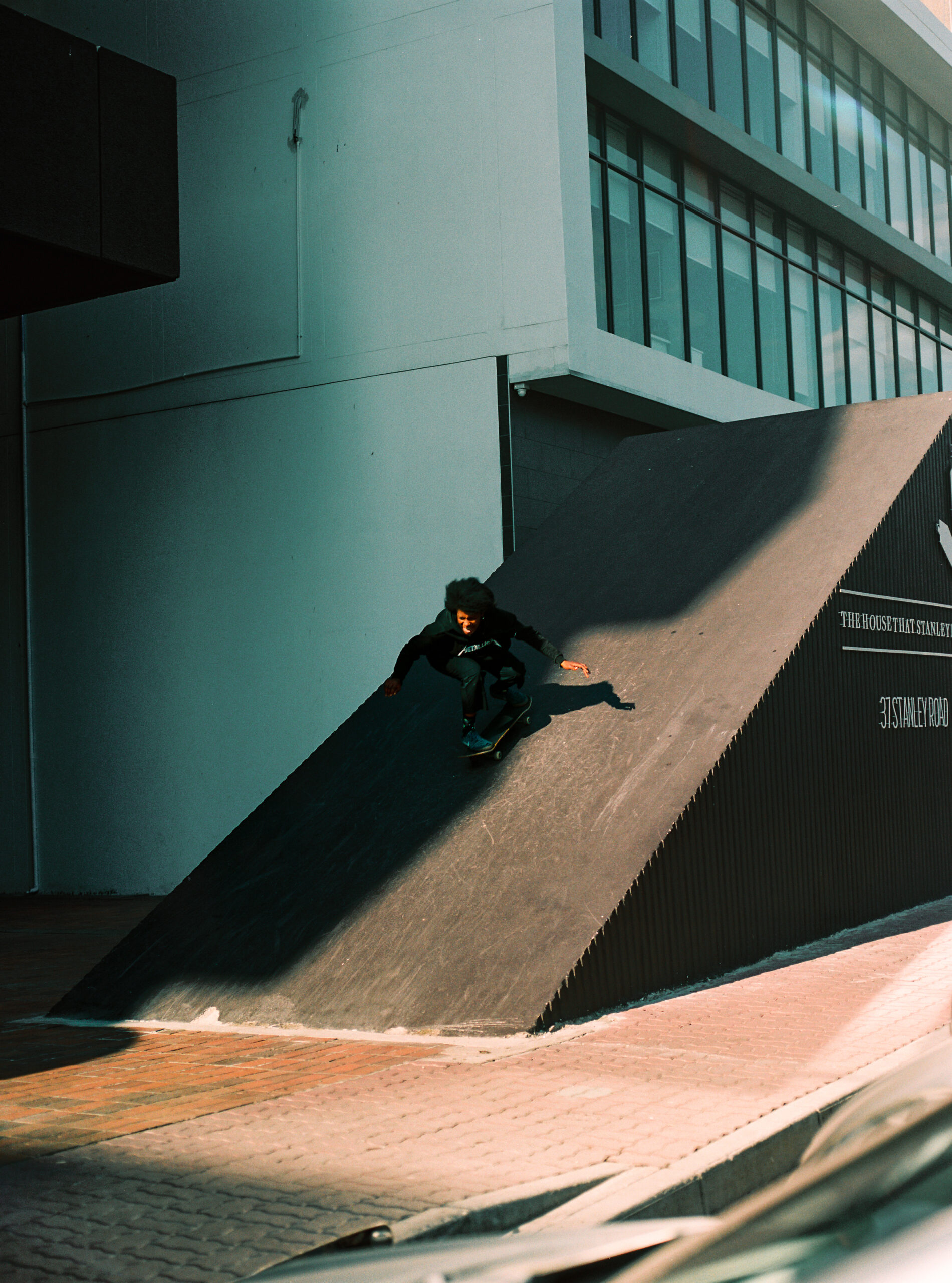
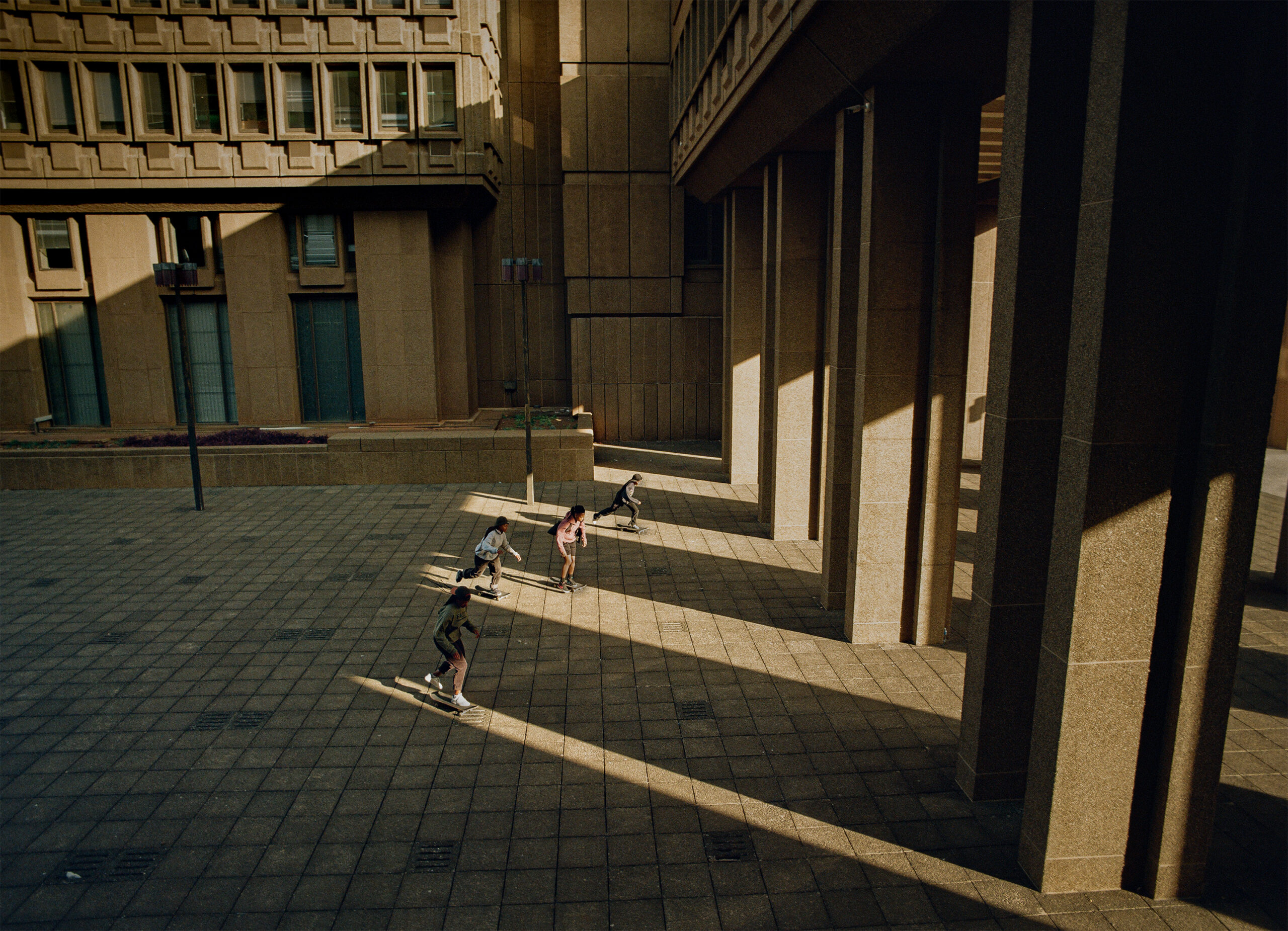
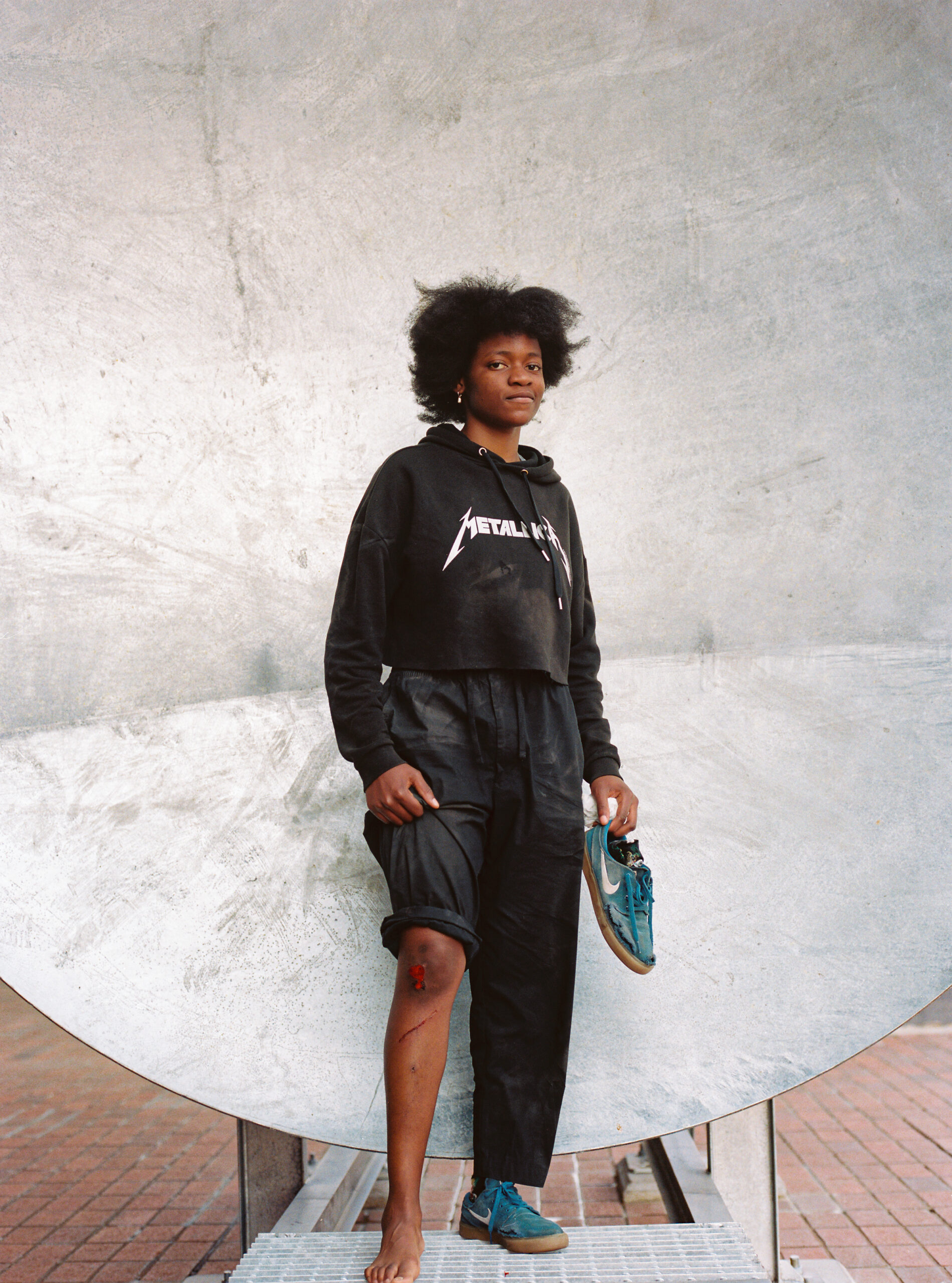
Heidi: How did the Black women’s Skateboarding project evolve – did you notice they were a force but underrepresented?
Karabo: Skateboarding isn’t always embraced by Black communities, and my own experiences having limited proximity to Black role models in skateboarding have had a massive impact on my feelings toward the sport and the culture of skateboarding. It’s made me wonder what skateboarding means to Black women immersing themselves in this world. What does it mean to take up space in a predominantly white male sport? I became aware of the increasing presence of Black women in skateboarding and then developed organic relationships with the community.
Understanding that South Africa has a tumultuous history with gender-based violence; the right to occupy public space is not equally shared amongst genders. Women are often met with harassment, micro-aggressions, and other threats that make them feel unsafe and unwelcoming in public spaces. Crews of skateboarders such as the “Island Gals” and “Spectrum” are recreating the narrative by actively organizing and occupying spaces that many have previously felt uncomfortable being in.
Their passion for skateboarding and community transcends through each individual and there is an undeniable sense of dedication to skateboarding and pushing for greater representation within the sport.
The collective work of Black women in skateboarding has been impossible to ignore, and as a documentarian, I found myself in the fortunate position of working alongside these dominant forces to help share their message globally.
How did you approach the female skateboarders, how did you explain your intentions to them?
As a documentarian, it is important for me to learn about the experiences of the community I am working with and to earn their trust. I invested time in understanding the community’s goals and spotlighting what they have overcome to realize their accomplishments.
I intend to create awareness and celebrate the importance of the social-political work perpetuated by these young freedom fighters. Many marginalized communities in post-apartheid South Africa are still carrying the weight of systematic oppression and my duty as a photographer is to let the truth be told and realized by local and global audiences.
Tell us how your style as a photographer evolved and how you got your start.
My passion for photography is rooted in my interest in human connectivity, history, and culture. I’ve been in a photographic dialogue most of my life, and the focus of my photography has developed from documenting counterculture to placing a more acute interest in political and cultural themes. Over time, I realized the weight of institutionalized colonialism that I was carrying and how systems of oppression had created doubt in my self-worth. This is why it is so important for me to highlight and celebrate Black culture in all its glory.
What were your influences then and now?
Not so much what, but who – Peter Magubane, Ernest Cole, Dawoud Bey, and Joseph Rodriguez have been great storytellers I have sought inspiration from. Documentarians whose work upheld a deep sense of integrity and truth. They sought to tell stories of communities close to them and the social-political work they achieved is everything I aspire to in my work.
How did the Freedom Charter inform the culture in Soweto and your work?
As I mentioned earlier, Peter Magubane and Ernest Cole are prominent South African photographers and freedom fighters who taught me the importance of adopting a revolutionary mindset.
I learned that photography is a powerful tool to decolonize my mind and that of the communities I began working with. Photography has taught me so much, especially the importance of searching and sharing the truth of my people’s stories. I focused on stories that invite viewers to engage with political and social issues.
Photography has allowed me to find my place amidst constant change and given me a voice to communicate and connect through this form of dialogue. The process has taught me to be intentional with my approach to photography and value the connections I’ve made with people along the way.
“As part of every encounter, Bey gave each person a small black-and-white Polaroid print for themselves as a way of reciprocating and returning something to the people who had allowed him to make their portrait” What practices do you have in any of your portraits encounters?
As an independent photographer, embarking on personal projects requires a lot of investment. I pour everything into realizing photo stories, but it’s not easy. Production costs are difficult to cover independently but as time goes on and my investments become greater, I find that simultaneously the relationships created are strengthened. My gratitude for the time and trust is expressed by upholding the integrity of the communities I work with. When I can afford to, I print out images on archival paper for the people I have worked with.
Ernest Cole’s House of Bondage It was six years in the making. Each chapter represents life under apartheid, illustrating segregation’s impact on housing, education, employment, childcare, medical care, and daily life – which images are the most memorable to you and why?
The image that is engraved in my mind is the image of a schoolboy who squats on his haunches in an overcrowded segregated classroom, beads of sweat streaming down his face as he intently grips a pencil and a notepad in his small hands, following along with the teacher’s lesson, Ernest Cole provided audiences outside of South Africa with their first visceral view of apartheid, his work draws viewers into the beauty of this quiet act of defiance, this small moment of creation, which Cole ensured would one day be seen. Cole’s work captured my people’s struggles, and his photography’s message lives on as historical moments in the liberation of Black communities.
What parallels exist between your skateboarding work and the AfroPunk scene images from your Dog Pound Days.
The AfroPunk skateboarding world brought together an unlikely group of Black and white youth, crossing a divide entrenched by Apartheid.
The makeshift independence of DIY culture is a crucial component of punk, where everything is self-constructed, from the experimental music and performances that take place in unconventional—and, as with skateboarding, sometimes unauthorized—locations, to crews building their ramps and filming. skate sessions. My images capture the energy of the punk/skateboarding scene—the freedom in its expressions of rage, the power that comes with asserting one’s own identity, and the culture’s deep camaraderie.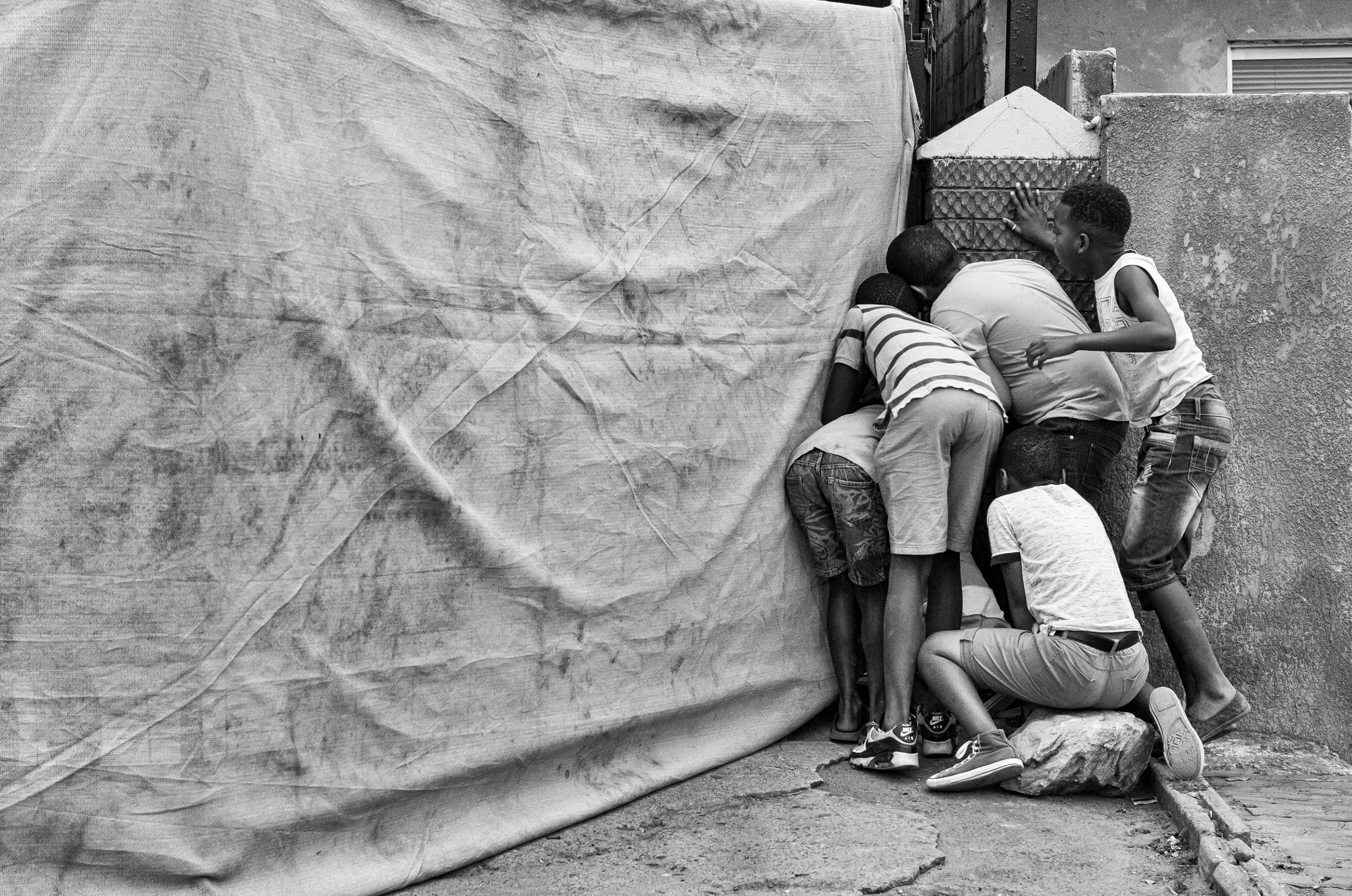


Afro-punk is forever
Jeanné has become known as a pioneer in South Africa for Black women in skateboarding. Seen cruising the streets of Johannesburg central business district, she defies style through her visual expression of self on the board and in her unconventional approach to fashion. Her punk attitude glows on and off of her skateboard, inspiring many others to shape their own identities as Black women in skateboarding.
Island Gals
Without the help of sponsors or any organizations Thato and Melissa have committed a life to skateboarding and conducting workshops for Black women interested in taking up the sport, sharing equipment and boards until they’re completely worn out. Their love for their community outweighs the cost of skateboarding.
In crust we trust
Mmabatho demonstrates what it takes to learn at her local park, where resources are few and far between, construction materials are subpar and the crumbling infrastructure to develop one’s own skill level is the only place where she can access close to home to get her daily fix. on the board.
exhale
Thabiso Mashiyakgomo makes it count, charging down the infamous “Siemens Bank” spot with a tail drop of a first for women in South African skateboarding. Her strength of will and progression of skill is a combination of grace and resistance that is carving a way for her and a community of Black women in skateboarding to be recognized for the space that they are taking up in a white male dominated sport.
spectrum
The women from the skate collective “Spectrum” cruise through the city streets of downtown Johannesburg, redefining the narrative of what it means to be African women in skateboarding in a city notoriously known for its high statistics of gender based violence. Making themselves visible in spaces that often discriminate against them, their determination to be comfortable wherever they roam has paved a way for many women to venture into the city’s landscapes on their boards like never before.
Blood-In, Blood-Out
Fearless and determined, Thabiso Mashiyakgomo parades her battle wounds with pride. The passion she pours into skateboarding is revealed on her scars and continues to drive her as a skateboarder, relentlessly taking on street spots and continuously shattering the glass ceiling of what it means to be a Black woman in skateboarding.
Dogg Pound Days Captions
1. Curious kids from the neighborhood try to get a glimpse of a punk show.
2. In true punk rock style, Thula ‘Stroof’ Sizwe – guitarist of TCIYF – continues to perform after being electrocuted by a short-circuited fuse.
3. Searching for street spots to skate in Soweto is challenging, both physically due to the lack of infrastructure and attitudinally due to the general population’s misperception of skate culture as one that is destructive and dangerous. The Soweto Skate Society has made it their mission to shatter the belief that skateboarding culture can only exist in spaces outside of the township.”